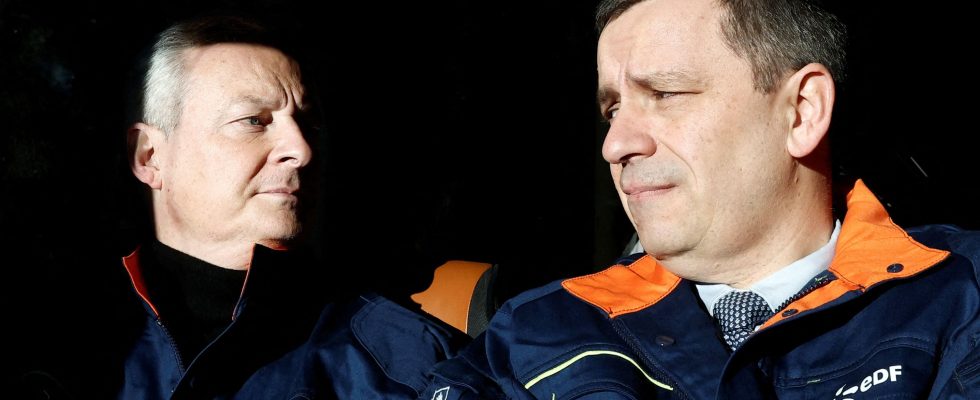The years go by, some struggles remain. In 2009, Pierre Gadonneix criticized the regulated electricity prices imposed on his company, EDF. Considering the latter to be undercalibrated, he wanted to increase them by 20%. Unthinkable for the government of the time. Fourteen years later, the same score is played again. Worried about the upcoming wall of expenses, Luc Rémont, appointed at the end of 2022 at the head of the French electrician, is calling for more financial room for maneuver. Firm response from the executive: the boss has fifteen days to review his copy.
“It’s exasperating. Once again, the government’s short-termism is opposed to the need to think about energy policy in the long term,” criticizes Fabien Bouglé, author of Energy war (editions du Rocher). At the group’s headquarters, the tension is palpable. “There are in fact two major sources of dissension between EDF and the State, underlines Alexandre Grillat, national secretary at CFE-CGC Energies. First of all, EDF may well be 100% owned by the State, it is a public limited company, not a public establishment of an industrial and commercial nature (Epic). In other words, it is not up to the State to manage the company, but to its president – general manager.”
Second point of tension: EDF must generate enough revenue to enable it to finance its numerous investments. “However, for almost thirty years, the State has always set prices not based on the reality of costs, but taking into account political or even electoral considerations. Over the decades, EDF has been chasing a normal economic model in vain. , stable and viable”, notes Alexandre Grillat.
A UFO in Europe
This situation makes France a UFO in Europe. “Everywhere, market logic has imposed itself. Electricity is exchanged like a product, in the same way as bananas or strawberries. But in France, EDF subsidizes households and businesses through regulated tariffs and Arenh (regulated access to historic nuclear electricity), a system which obliges the energy company to sell electricity below market prices to its competitors”, explains Damien Ernst, professor at the University of Liège and at Télécom Paris.
Result ? “This system cost EDF billions of euros, without really protecting consumers,” laments Hervé Machenaud, former executive director of the group. In twenty years, regulated prices have increased by almost 100%. “Contrary to popular belief, the more Arenh is used, the more prices rise, due to two complex mechanisms,” adds the former manager. Twice a year, the Energy Regulatory Commission (CRE) sets the evolution of regulated prices. However, part of its calculation is indexed to the European spot market, with daily expiry. At the same time, with the crisis, the recent return of many customers to EDF is forcing the company to buy more production on the market at a high price, which contributes to tensions on the market.
“We built a gas factory, and no one understands anything about it anymore,” laments an energy expert. “The smartest thing to do would undoubtedly be to let EDF sell electricity at the price it wants. The State could then receive dividends and use this money to help the most modest households,” estimates Damien Ernst. But the executive does not necessarily see it that way. “When I listen to the statements of Emmanuel Macron or Elisabeth Borne, I fear that the government will choose the administered economy,” predicts former Minister of the Environment Brice Lalonde.
Don’t reinvent powder
“Since the prospect of changing the European electricity market seems out of reach, the government is now relying on CFDs (contracts for difference) in order to protect consumers. The principle ? If the market price turns out to be higher than a range defined in advance, EDF will reimburse the difference to the government, and the latter will return the amount to consumers”, explains Jean-Jacques Nieuviaert, president of the Société d’ studies and energy prospects. The problem? We remain on a complex system, which EDF does not want.
Rather than reinventing the wheel, it would be better to seriously look at EDF’s production costs, several specialists point out. In a recent note, the CRE evaluates it at 60 euros per megawatt hour. But this figure does not include the construction of future EPRs. The State will have to decide. A figure around 80 or 90 euros could be a good compromise. Except that it would mean an increase in prices. “In order to cushion the shock, the most energy-intensive companies could pay for part of the future nuclear reactors in exchange for a preferential electricity rate. This system has already been used in the past,” recalls Jean-Jacques Nieuviaert . As for consumers, accustomed to paying cheaply for their electricity, a reasonable effort also seems possible. “Even with a 20% increase in prices, we would remain below what Belgian or German households pay. And there is always the possibility for the State to support them,” continues the expert. Will the government dare to take this path? By remaining too cautious, it runs the risk of weakening the financing of our electricity production system.
“Margins are shrinking. The French exception in terms of prices cannot last forever,” warns Damien Ernst. Alexandre Grillat points to another solution: the State benefits greatly from VAT on electricity. Why not reduce it, in order to reduce the French’s bill, given that electricity is an essential good? “We accuse EDF of wanting to increase prices. But, one day or another, we will have to put the real data of the equation back on the table.”
